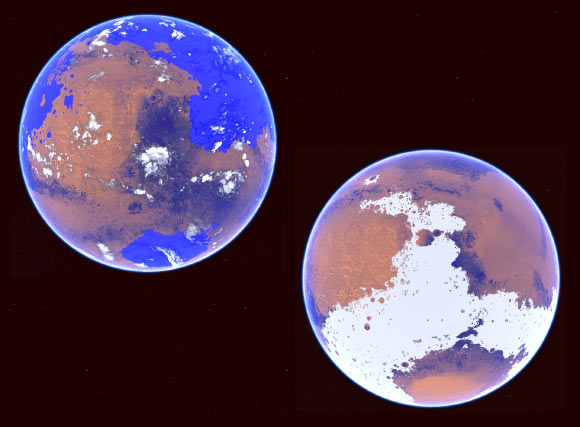A new study published online in the Journal of Geophysical Research – Planets suggests that a frigid, icy planet 3 – 4 billion years ago better explains water drainage and erosion features seen on the planet’s surface today.

An artist’s impression of the ancient ocean on Mars. Image credit: M. Kornmesser / ESO / N. Risinger, skysurvey.org.
For years, planetary scientists have debated the climate history of Mars and how the planet’s early climate led to the many water-carved channels seen today.
The idea that 3 to 4 billion years ago the planet was once warm, wet and Earth-like with a northern sea is generally more popular than that of a cold, icy planet where water is locked in ice most of the time and life would be hard put to evolve.
To see which early Mars better explains the modern features of the planet, a group of scientists led by Dr Robin Wordsworth of Harvard University used a 3D general circulation model to compare the Martian hydrological cycle in ‘warm and wet’ and ‘cold and icy’ scenarios 3 – 4 billion years ago, during what’s called the late Noachian and early Hesperian periods.
One scenario looked at Mars as a warm and wet planet with an average temperature of 50 degrees Fahrenheit (10 degrees Celsius) and the other as a cold and icy world with an average global temperature of minus 48 degrees Celsius (minus 54 degrees Fahrenheit).
Dr Wordsworth and his colleagues found that the cold scenario was more likely to have occurred than the warm scenario, based on what is known about the history of the Sun and the tilt of Mars’s axis 3 to 4 billion years ago.
The cold model also did a better job explaining the water erosion features that have been left behind on the Red Planet’s surface, and which have puzzled scientists since they were first discovered by the Viking orbiters in the 1970s.
“Our results show that the cold scenario matches the surface distribution of erosion features more closely. This strongly suggests that early Mars was generally cold, and water was supplied to the highland regions as snow, not as rain,” Dr Wordsworth explained.

Conceptual rendition of the competing warm and cold scenarios for early Mars. Image credit: Robin D. Wordsworth.
Dr Bethany Ehlmann from the California Institute of Technology and NASA’s JPL in Pasadena, who was not involved in the new study, added: “proving that a cold climate on early Mars led to the features seen on the planet today is a big question.”
“The study answers part of that question by showing that locations with snow accumulation in the cold and icy scenario roughly correspond to valley network locations seen today.”
“Further, the model of the cold and icy early Mars shows that some melting of ice would occur.”
“We know from rover- and orbiter-based data that there were lakes on ancient Mars. Key questions are: how long did they persist? Were they episodic or persistent? And does the feeder valley network demand rain or is snow and ice melt sufficient?”
She added: “the 3-D climate modeling used in the new study begins to address these questions with a new level of sophistication by investigating how specific locations might have accumulated rain or snow.”
_____
Robin D. Wordsworth et al. Comparison of “warm and wet” and “cold and icy” scenarios for early Mars in a 3D climate model. Journal of Geophysical Research – Planets, published online June 01, 2015; doi: 10.1002/2015JE004787







